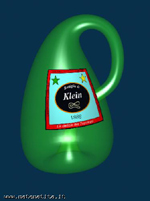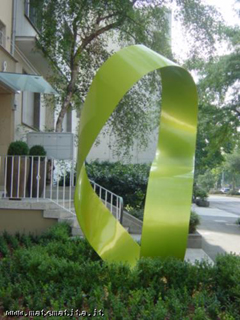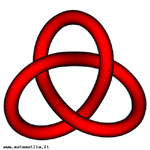This is the text of the poster you can see here.
When a Doughnut is Equal to a Coffee Mug
To agree on the meaning of the word “surface”, you just need to think of the “skins” of the objects (at least, almost any) of everyday’s life. Some of them are smooth like the skin of a ball. Others are sharp-cornered like that of a cube. All of them share the same characteristic. If you imagine to take into account a small piece of it and zoom in, you essentially obtain something which is similar to the plane, where two coordinates can identify the position of a point. We can distinguish scenarios like those of a sphere and a cube from those of a cylinder and a Moebius strip... In these last surfaces, there are points where the surface “ends” and has a boundary. If you zoomed on the points of this boundary, you would find something analogous to a half-plane and not to a plane.
A surface (with or without boundary) is however characterized by a local property: zooming in gives something similar to a plane or, at most, to a half-plane.
What can we say from a global point of view? Surfaces are not all alike not even within Topology, which seems indeed … so compliant that it allows itself to view as equal the surface of the sphere and that of the cube. For a topologist, all information related to measurements are meaningless. You can imagine to stretch an object as much as you want. The object will stay equal to the original one as long as it is made out of a sufficiently deformable material which prevents from breaking it. Cutting into pieces is not an allowed operation for it unless you do not glue the different parts by taking care of glueing the points which were unglued.
Thus, how many and which are the “different” surfaces with these rules of the game?
To begin with, to agree on the surfaces we are referring to, we need to say that they are connected (i.e., made up by one piece), compact (a more technical hypothesis that guarantees that the surface is bounded and that there are no holes like those made by a pin when removing a point), oriented (i.e., they do not contain a Moebius strip) and without boundary.
A sphere and a torus are oriented surfaces without boundary; clearly, they are different.
A disc and a cylinder are oriented surfaces with boundary. The boundary is a circumference in the first case and two circumferences in the second case.

A Moebius strip is a non-orientable surface with boundary (and the boundary is a circumference – of course, with a topologist’s eye!).
An example of a non-orientable surface without boundary is the Klein bottle. Actually, it must be imagined in a different guise than that in which it is usually depicted, or in a three-dimensional model. In fact, with the mind’s eyes you should disregard the self-intersecting curve. You should think of this curve as an “accident” due to the fact that the Klein bottle (which needs wider space) has been “constrained” to the three-dimensional world.
It is like when you draw a knot on a sheet of paper. In a projection, we see some crossings which do not exist in the in the “real” Knot. They are due to the restriction of drawing on a sheet of paper, whereas the knot needs more space. It needs three dimensions: two dimensions are not enough.
Analogously, the Klein bottle (like all other non-orientable surfaces without boundary) needs four dimensions. There is no way of representing it in three-dimensional world without self-intersecting curves.



